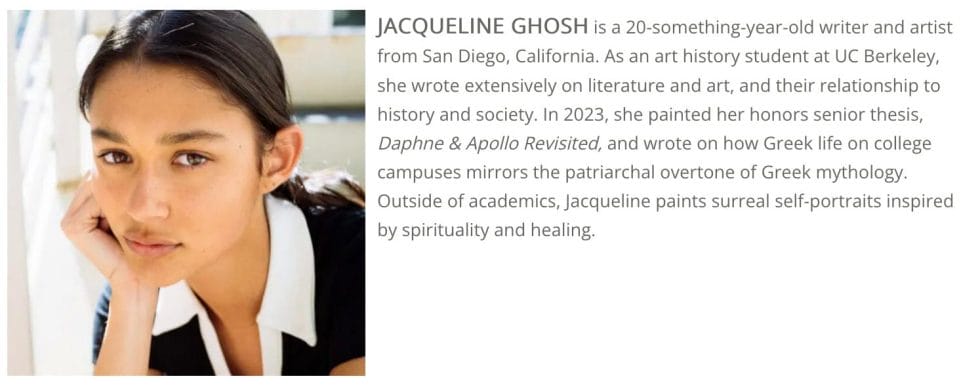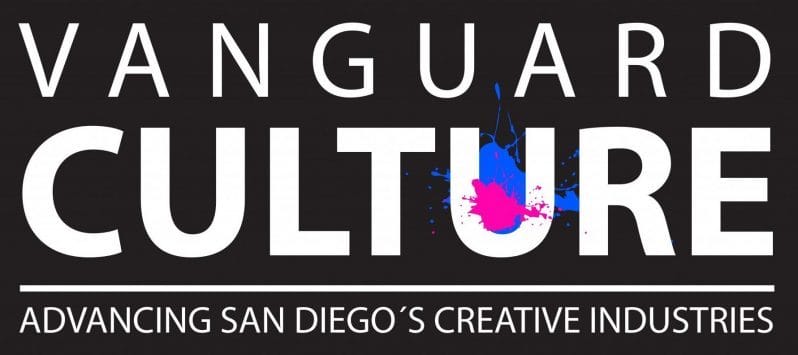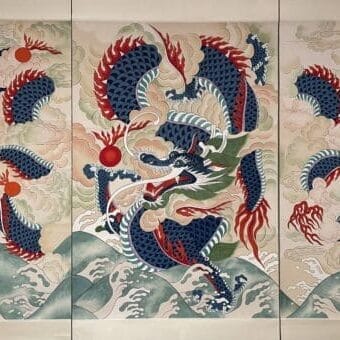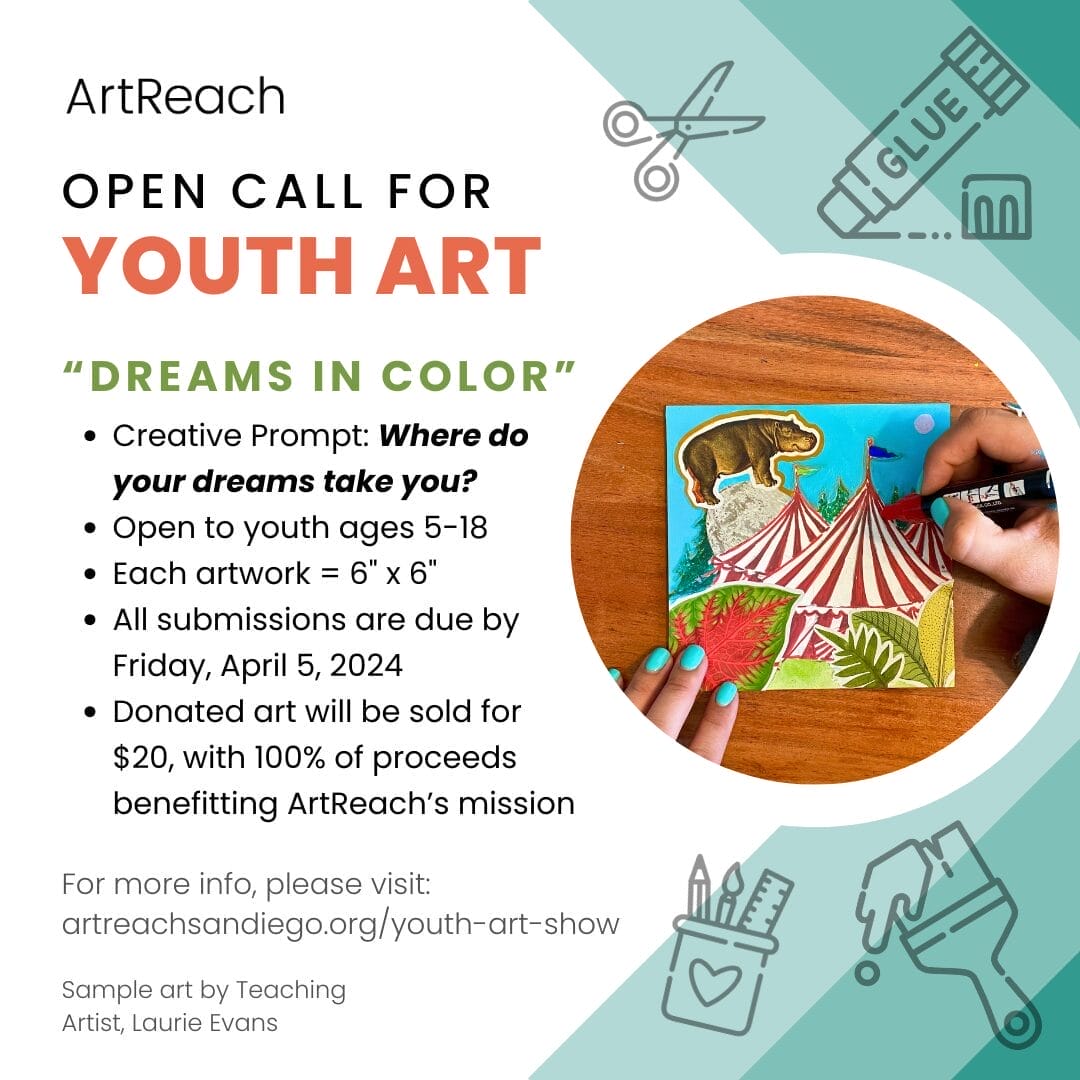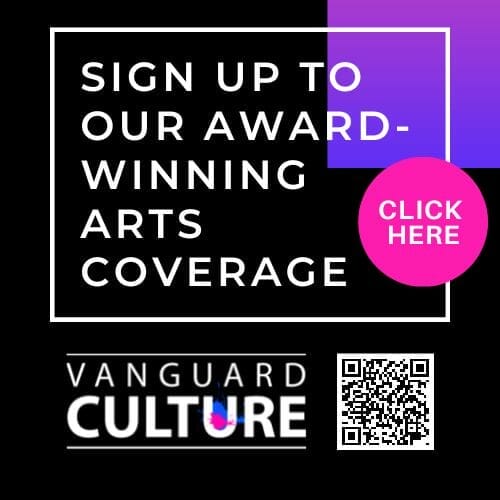November 28, 2023
By Jacqueline Ghosh
On October 28th, the San Diego Museum of Art welcomed a stunning collection of artwork from South Korea’s Museum of Modern and Contemporary Art. Korea in Color: A Legacy of Auspicious Images explores the legacy of polychrome painting and fortune-bringing imagery. Past and present reflect one another as 19th-century works contextualize contemporary ones. The collection is composed of 50 pieces organized into four sections, each illustrating art’s unique role in daily Korean life. The first is protection, represented by the five primary directions, colors, and guardian animals. The second is good fortune, symbolized by abundant scenes in the garden. Third is edification, intellectual tools found in the study. Fourth is appreciation, illustrated by colossal paintings of mountains.
I had the privilege of receiving a tour from SDMA’s Associate Curator of Modern and Contemporary Art, Rachel Jans, Ph.D. I met Dr. Jans in the presence of a lacquer tiger that gazed past us with enormous orange eyes. Each hair of its yellow stripes glowed vividly against the black background. “Imagine that we’re in a traditional Korean house,” she says. “It’s being guarded by all of these incredible animals, especially the tigers.”
Seopang’s Fierce Tiger Woke Up is a contemporary rendition of the popular motif in Korean folk art. Korea was known as the “Land of Tigers” before the native population was hunted to extinction in 1940. The peninsula is also said to resemble the shape of a tiger. Its appearance in artwork represents the strength of the Korean people. Pine trees symbolize longevity and magpies are bearers of good news. These auspicious images enliven the room with positive energy.

Fierce Tiger Woke Up. Seopang. 2012. Lacquer on Panel. Image courtesy of the SDMA.
“One interesting thing about polychrome painting, which was in Korea from 1492 to 1910, is that it permeated all sectors of life,” continued Dr. Jans as we passed a series of portraits: a dog with a beard resembling that of a Joseon Dynasty monarch. “These kinds of things were found in the whole strata of life, as well as in secular and sacred realms. That’s one of the unique things about the culture, the way things moved back and forth, up and down.”
We entered a dark alcove with videos of dancers on each wall. We stood at the center of the room, illuminated by a yellow halo. “This is a dance,” Dr. Jans explained. “There are four dancers, each in different colors. You’ll see these colors throughout the exhibition: red, blue, white, black, and yellow. They all relate to different directions and have different properties.” Each dancer wears a mask bearing auspicious images of peonies and peaches. They perform the ancient shamanistic dance of Cheoyongmu to ward off evil spirits. “On us, there is a yellow light. The visitor themself becomes a part of the exhibition. […] Yellow is the fifth direction, the center.”
Exploring this concept further, we entered a room with paintings on each wall and the center of the floor. “This instillation adds the guardian animals associated with the cardinal directions,” says Dr. Jans. A black tortoise to the north, a white tiger to the west, a blue dragon to the east, a vermilion phoenix to the south, and a yellow dragon to the center. “This arrangement would relate to an ancient tomb. The guardian animals protect the person inside.”
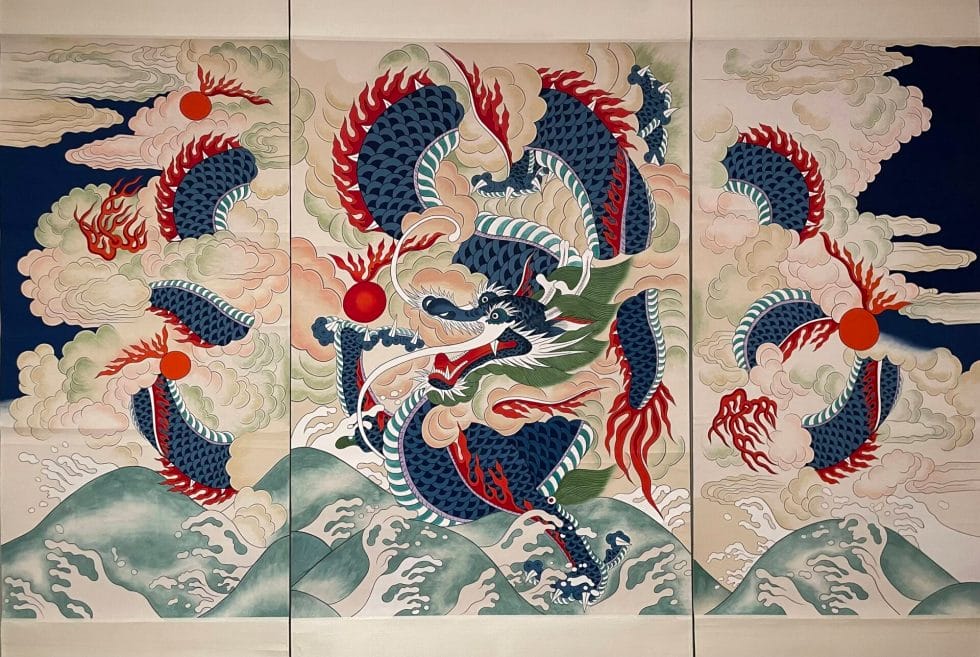
Azure Dragon. Oh Soon-Kyung. 2021. Oil on linen. Photo by Jacqueline Ghosh.
Afterward, we stepped into the garden. “Here, you see this conversation between historic and contemporary pieces,” Dr. Jans tells me in front of a 19th-century folding screen with peonies. On the opposite side of the wall is a 21st-century rendering of the same subject, Metamorphozied Peonies by Kim Chonghak. Chonghak’s exaggerated, free-form flowers juxtapose the standardization of older times. I couldn’t help but compare Metamorphized Peonies to a folding screen I saw at the Gyeongbokgung Royal Palace Museum in Korea. Perhaps this was the artist’s inspiration. Chonghak is known for experimental, expressionist work inspired by the natural world.
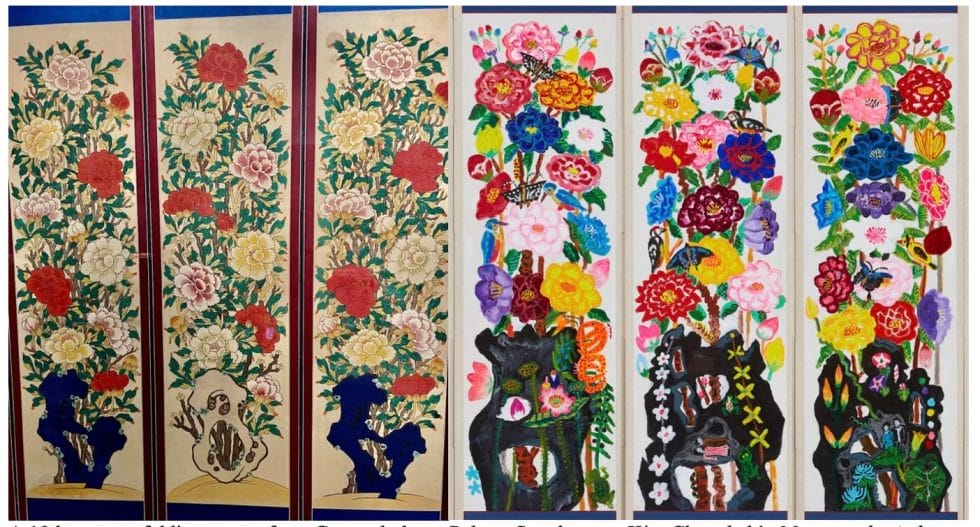
A 19th-century folding screen from Gyeongbokgug Palace, Seoul versus Kim Chonghak’s Metamorphozied Peonies. Acrylic on Canvas. 2006. Photos by Jacqueline Ghosh.
We approached another 19th-century folding screen depicting the Ten Symbols of Longevity. The symbols are common in Asia, but Korea is unique in that it brings all ten together. Dr. Jan explains their function: “The beautiful red sun, the clouds, the water, and the rocks are the natural objects representing the importance of harmony. […] Then there are the things that are growing which are—we’ve seen these before—the pine trees, and the bamboo. Both are evergreens, they live throughout all the seasons. […] And then there’s the mushrooms. Like today with the trend of medicinal mushrooms, the practice goes back to ancient times. I think it’s hilarious watching the deer eat the mushrooms.” The deer is a symbol of immortality, the tortoise of longevity, and the crane is a heavenly messenger.
The narrow corridor gave way to an expansive gallery filled with vibrant florals. An installation of neon paintings illuminated the space. “These works, by Kim Yongchul, play with symbols and language,” Dr. Jans tells me. “He’s taking the peony, a symbol of abundance that is immediately recognizable, and pairing it with symbols of the West, like the heart.” Throughout the paintings are Korean phrases with English pronunciation below. In Korea, it is assumed that most people can read some English. “I think it’s wonderful that Yongchul has brought this work here, to San Diego, to this context where people don’t know Korean phrases. He’s offering them the chance to learn.” The works are precisely arranged according to Yongchul’s design.

Da Hamakke-Hangukmal-eul Baewooja (All Together—Let’s Learn Korean). Kim Yongchul. Various media. 2007-2023. Photo by Jacqueline Ghosh.
Meticulously detailed still-life paintings flank the study’s walls. Bookshelves filled with books, fruits, scrolls, peacock feathers, telescopes, and scholarly objects appear real enough to reach out and grab. Enchanting Korean characters adorn massive white canvases. Together they read “spellbound.” Across the hall, orange ideographs of Chinese characters form a psychedelic pair. The first represents a human asking god for guidance. The second is god’s ambiguous answer: “dismal,” it reads.
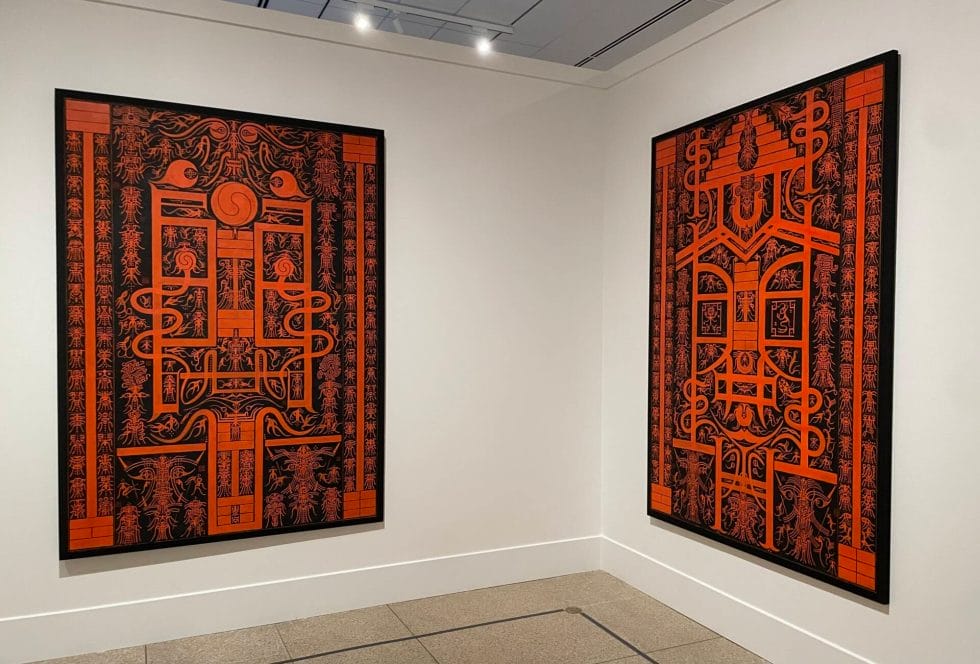
Pray and Seek (left) and God Visits The Dark (right).Kim Jongwon. Cinnabar and ink on paper. 2021. Photo by Jacqueline Ghosh.
Next, Dr. Jans introduced me to the exhibit’s most unusual spectacle. “This is about documented life,” she says. “It’s a different way of thinking about documentation than we may think in the West.” This practice is rooted in Buddhist tradition. “This is called Subway Hell Scroll,” Dr. Jans tells me with a laugh. Hell Scrolls illustrate the suffering of sinners in one of the Eight Buddhist Hells. It’s truly diabolical. Demons spank a naked man with a paddle. Grimacing clowns boil in a cauldron with pigs. An elongated dog lifts its leg on a gigantic doll. If we’re talking about provocative imagery, this floor-to-ceiling painting gives Hieronymus Bosch a run for his money.
At the threshold of the fourth and final section, Dr. Jans recalled our journey: “So, we entered the space, it was guarded by the animals offering protection. Then we went out to the garden and went into the study. Now we’re looking over the wall of this ‘house’ at the mountains.” Korea is about 70% mountains. Traditionally they are considered divine places where heaven meets earth. In Geumgang Jeondo, granite peaks resemble human figures ascending the mountain seeking enlightenment. In Sacred Mt. Baekdu, a volcanic lake reaches past the clouds where it greets the sun and moon.
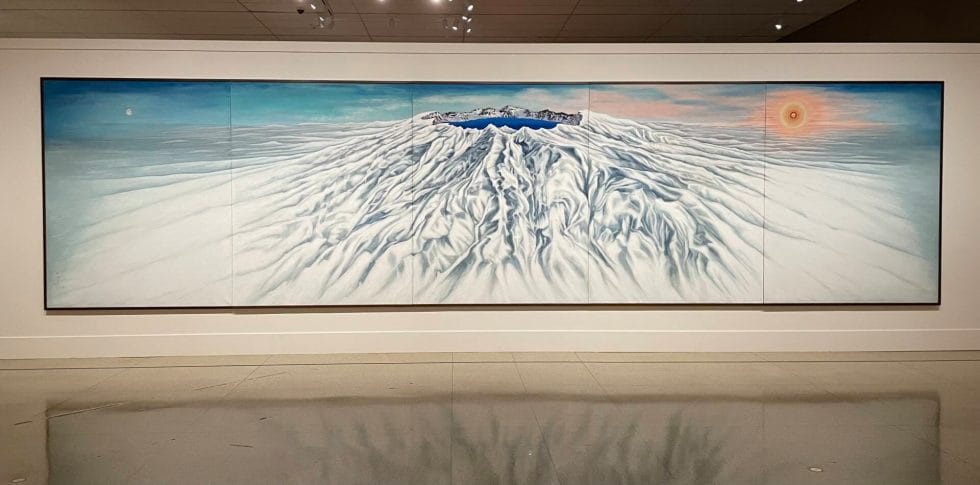
Sacred Mt. Baekdu. Lee Sokja. Pigment on paper. 2016. Photo by Jacqueline Ghosh.
Korea in Color is a rich tapestry of artistry where modernity and tradition intertwine. One will discover not only protective guardians, abundant gardens, scholarly studies, and majestic mountains, but also the intricate interplay of symbols and stories that define Korean heritage. This exhibition is a testament to the enduring power of art, leaving the viewer captivated by the harmonious dance between past and present, inviting us to reflect on the timeless virtues and narratives that have stood the test of time.
Korea in Color is on view at the San Diego Museum of Art until March 3, 2024. The museum is located at 1450 El Prado. Their regular hours are Monday-Saturday 10 a.m.-5 p.m., and Sunday 12 p.m.-5 p.m. The museum is closed on Wednesday.

